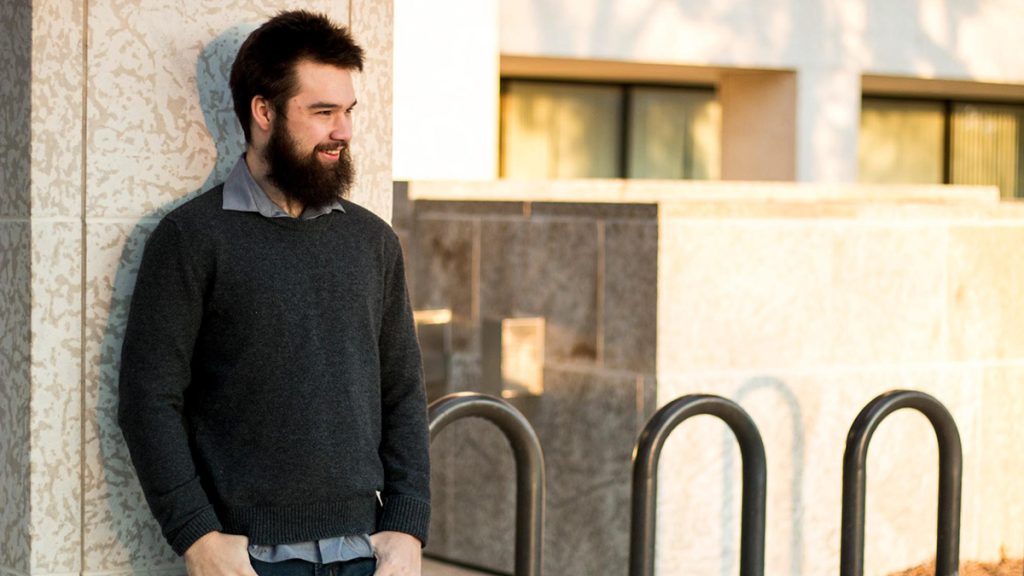
How we start building access for disabled journalists
I probably shouldn’t start this with a wheelchair pun, should I?
The views expressed in this column are those of the author and do not necessarily reflect the views of the Reynolds Journalism Institute or the University of Missouri.
John Loeppky is a RJI Columnist whose column will explore issues that focus on journalism innovation through the lens of disability and freelancing.
As a disabled freelance journalist, my identity is never all that far from the surface. For example, my Twitter bio — yes, I really would like to start being there less and no, I don’t want to talk about it— begins with the words “crippled and creative.” Most of my professional bios online end with the sentence, “John’s goal in life is to have an entertaining obituary to read.” To put it bluntly, you get what you pay for: A fairly loud (yet anxious) multiply-disabled writer who didn’t go to journalism school and is still recovering from the workaholic tendencies that enveloped most of his twenties.
What does this have to do with this column? Well, I sit at three intersections where I will provide some value for as long as the RJI will have me. For one, I’m a Canadian whose clients are mostly American; I’m a former athlete and artist, two identities that I think the wider journalism industry can learn a heck of a lot from; and lastly, I’m a person who has done everything he can do to not have a staff job post-student media. I’m interested in how we can innovate, how we can support each other, and how we can create access.
And don’t worry, even if you’re not disabled, you’re allowed to laugh at any disabled jokes I happen to make. It’s how I cope. Shall we?
How many disabled journalists are there really?
Short answer: We don’t know, but it’s certainly more than we think we have. Depending on who you ask — after all, when it comes to any numbers question there are lies, statistics, and overly caffeinated data journalists trying to figure out the difference between the three — 15 to 20% of the worldwide population is disabled. A recent British report puts their number of UK disabled journalists at between 14 and 16%. If anecdotal evidence is anything to go by, because we don’t have reliable data, that number is as high in North America. For context, research puts the percentage of disabled Americans at closer to 26%.
Even if we had a solid number, we still have to be careful when painting disability in the industry with a broad brush. Why? Because the vast majority of disabled journalists don’t have the privilege of being out and proud. I’d argue most can’t be out at all. They’re still trying to figure out their relationship to the label and all of its stigma, or it could be because they don’t have support from their colleagues, or it could be for a multitude of equally discriminatory reasons.
I have crippled and creative in my bio because 1) I am a fan of reclaimed language, and 2) because my former life in the non-profit and sport world(s) mean that my diagnosis has been written about many times. I can hide my wheelchair on a Zoom call, I can choose not to disclose to editors, but I find it counterintuitive. Many of my colleagues aren’t as lucky — and I dream of a future where disabled journalists are carving their own paths with more regularity in a way that allows them to be their full authentic selves. But, I don’t believe us disabled people can do that on our own.
The root of the problem
Like it or not, our industry has an incredible bias against disabled reporters. We are often confined, not to our adaptive devices (as what seems like one in three story ledes about disabled sources would have you believe) but to a little proverbial corner with the words “trauma op-eds” scrawled on the wall behind us.
We have to be given control over our own stories before we can begin to make a dent in stories we can tell about others. And this lack of progress creates a self-fulfilling prophecy. I get frustrated when I see disabled journalists who haven’t been given any room to grow. They write about their lived experience, never getting to do broader reporting – let alone the kind of work we need more of in the world – because they’re being slapped with the same label so many other marginalized journalists are: they’re being told that they can’t be activists and journalists.
But, we have to be activists in order to get into these spaces and jobs. I well and truly lucked into this work at the beginning. I happened to sit down next to my campus paper’s editor-in-chief on my first day of university. I happened to be given the space to publish some truly cringy stuff that you can still find on the internet. I happened to be supported in figuring out what my very disability-forward writing, interviewing, and editing style was. One of the goals of this column is to provide opportunities for skill building so that you can provide, or find your way into, a safe space as well. It’s not easy work, it’s messy, but it can be a space for joy.
Related, It is my belief that good journalism about and/or by disabled people, no matter the beat, has to be rooted in solutions journalism. It doesn’t have to be a super obvious call to action, it doesn’t have to be the daily news version of ramming down the door, it can just be making a point of asking disabled people about a city council decision and naming when their accessibility committee is looking for new members. It can be pointing to the history of disabled people in your local sporting organization of note’s history. Small increments can create huge change.
I’m biased, but I truly believe there is a disability angle to any story that crosses a news desk. What we have to learn to do is to see those angles with more regularity and assign people to them who have put in the work to know how to report on these stories equitably. .
So, what can you do?
Lest I sound like someone on a very unsteady soapbox, not least because I’m an ambulatory wheelchair user with less balance than most, here’s some actionable advice — whether you’re a disabled journalist or not.
- Familiarize yourself with the National Center on Disability and Journalism (NCDJ) guidelines. They will give you a sense of how the language around disability is changing. The AP will catch up eventually, or at least we can hope they will. Also, look at your house style guide. Is it outdated when it comes to disability? If so, ask yourself what role you can have in updating it.
- Make a point of finding stories by disabled journalists in your area. Ask around, we’re often hiding in plain sight. If you’re a disabled journalist and you think you have a fairly good grasp of who is out there, focus on another country or a beat/niche you rarely engage with.
- This is going to sound trite but, if you’re an editor, search the word disabled on your own website. You might be shocked with how few results come back.
- Examine your remote working policy, many disabled people rely on the flexibility they provide, especially if they don’t have the institutional backing to ask for formal accommodations.
And lastly, share how you think you can increase access to disabled staff and freelancers in your own journalistic sphere.
